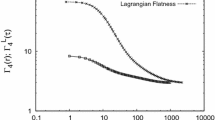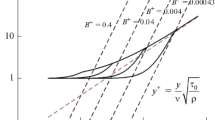Abstract
A review of interesting current topics in turbulence research is decorated with examples of popular fallacies about the behaviour of turbulence. Topics include the status of the Law of the Wall, especially in compressible flow; analogies between the effects of Reynolds number, pressure gradient, unsteadiness and roughness change; the status of Kolmogorov's universal equilibrium theory and local isotropy of the small eddies; turbulence modelling, with reference to universality, pressure-strain modelling and the dissipation equation; and chaos. Fallacies include the mixing-length concept; the effect of pressure gradient on Reynolds shear stress; the separability of time and space derivatives; models of the dissipation equation; and chaos.
Similar content being viewed by others
References
Akselvoll, K.; Moin, P. 1993: Large-eddy simulation of a backward-facing step flow. Engineering Turbulence Modelling and Experiments 2, (W. Rodi and F. Martelli, Eds.) Elsevier, pp 303–313.
Baldwin, B. S.; Barth, T. J. 1990: A one-equation turbulence transport model for high Reynolds number wall-bounded flows* NASA TM-102847: see also AIAA-91-0610, 1991.
Baldwin, B. S.; Lomax, H. 1978: Thin-layer approxiumation and algebraic model for separated turbulent flows. AIAA-78–257.
Birch, S. F.; Eggers, J. M. 1973: A critical review of the experimental data for developed free turbulent shear layers. NASA SP-321, pp 11–37.
Bradshaw, P. 1967: ‘Inactive’ motion and pressure fluctations in turbulent boundary layers. J Fluid Mech 30:241–258.
Bradshaw, P. 1974: Possible origin of Prandtl's mixing length theory. Nature 249, 135–136.
Bradshaw, P.; Mansour, N. N.; Piomelli, U. 1987: On local approximations of the pressure-strain term in turbulence models. Proceedings of the Summer Program 1987, NASA Ames-Stanford Center for Turbulence Research, pp 159—164.
Brown, G. L.; Roshko, A. 1974: On density effects and large structure in turbulent mixing layers. J. Fluid Mech. 64, 775–816.
Coles, D. 1969: The young person's guide to the data. Computation of Turbulent Boundary Layers — 1968 AFOSR-IFP-Stanford Conference, vol II (D.E. Coles and E.A. Hirst, Eds), Thermosciences Division, Stanford University, pp 1–45.
Corrsin, S. 1973: Comment on ‘Transport equations in turbulence’. Phys. Fluids 16, 157–158.
Diessler, R. G. 1989: On the Nature of Navier-Stokes Turbulence, NASA Tech. Memo. 109183.
Durbin, P. A. 1993: A Reynolds-stress model for near wall turbulence. J. Fluid Mech. 249, 465–498.
Germano, M. 1992: Turbulence — the filtering approach. J. Fluid Mech. 238, 325–336.
Gleick, J. 1988: Chaos: Making a New Science, Penguin Books, New York.
Goldstein, S. 1972: The Navier-Stokes Equations and the Bulk Viscosity of Simple Gases. J. Math. and Phys. Sci. (University of Madras) 6, 225–261.
Grant, H. L. 1958: The large eddies of turbulent motion. J. Fluid Mech. 4, 149–190.
Hong, S. K.; Murthy, S. N. B. 1986: Pressure-strain correlations in curved wall boundary layers. AIAA J 24, 971–998.
Huang, P. G.; Bradshaw, P.; Coakley, T. J. 1993: Turbulence models for compressible boundary layers. To appear in AIAA J, vol. 32.
Kays, W. M.; Crawford, M. E. 1993: Convective Heat and Mass Transfer, 3rd Ed, McGraw-Hill, New York.
Keefe, L. 1990: Connecting coherent structures and strange attractors. Near-Wall Turbulence — 1988 Zaric Memorial Conference (S. J. Kline and N. H. Afgan, Eds.), Hemisphere, Washington, pp 63–80.
Kuznetsov, V. R.; Praskovsky, A. A.; Sabelnikov, V. A. 1992: Finescale turbulence structure of intermittent shear flows. J. Fluid Mech. 243, 595–622.
Lamb, H. 1916: Hydrodynamics. University Press, Cambridge.
Le, H.; Moin, P. 1992: Direct numerical simulation of turbulent flow over a backward-facing step. NASA Ames/Stanford Center for Turb. Research, Ann. Res. Briefs, pp 161–173.
Leslie, D. C. 1973: Developments in the Theory of Turbulence. Clarendon Press, Oxford.
Papamoschou, D.; Roshko, A. 1989: The compressible turbulent shear layer — an experimental study. J. Fluid Mech. 197, 453–477.
Robinson, S. K. 1991: The kinematics of turbulent boundary layer structure. PhD thesis, Stanford Univ., and NASA TM 103859: see also Ann. Rev. Fluid Mech. 23, 601–639.
Sarkar, S.; Erlebacher, G.; Hussaini, M. Y.; Kreiss, H. O. 1991: The analysis and modeling of dilatational terms in compressible turbulence. J. Fluid Mech. 227, 473–493.
Selig, M.; Andreopoulos, J.; Muck, K.; Dussauge, J.; Smits, A. J. 1989: Turbulence structure in a shock wave/turbulent boundary layer interaction. AIAA J 27, 862–869.
Simpson, R. L. 1967: The turbulent boundary layer on a porous plate: an experimental study of the fluid dynamics with injection and suction. PhD thesis and Rept. no HMT-2, Stanford University.
Spalart, P. R.; Allmaras, S. R. 1992: A one-equation turbulence model for aerodynamic flows. AIAA-92-0439.
Tardu, F. S.; Binder, G. 1993: Wall shear stress modulation in unsteady turbulent channel flow with high imposed frequencies. Phys. Fluids A5, 2028–2037.
Townsend, A. A. 1956: The Structure of Turbulent Shear Flow. University Press, Cambridge.
Townsend, A.A. 1961: Equilibrium layers and wall turbulence. J. Fluid Mech. 11, 97–120.
Wilcos, D. C. 1992: Dilatation-dissipation corrections for advanced turbulence models. AIAA J 30, 2639–2646.
Wood, D. H. 1980: A reattaching, turbulent, thin shear layer. PhD thesis, Imperial College, London.
Zeman, O. 1990; Dilatation dissipation — the concept and application in modeling compressible mixing layers. Phys Fluids A2, 178–188.
Author information
Authors and Affiliations
Additional information
This paper was originally presented, as the Third Stewartson Memorial Lecture, at the Symposium on Numerical and Physical Aspects of Aerodynamic Flows, Long Beach, 1992. The present version includes some new material and omits some jokes.
Rights and permissions
About this article
Cite this article
Bradshaw, P. Turbulence: the chief outstanding difficulty of our subject. Experiments in Fluids 16, 203–216 (1994). https://doi.org/10.1007/BF00206540
Received:
Accepted:
Issue Date:
DOI: https://doi.org/10.1007/BF00206540




